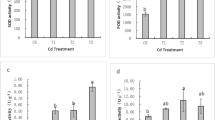Abstract
The objective of this research was to determine the phytoremediation potential of Eucalyptus globulus in Cd contaminated soil through two different harvest methods. Although replanting is more expensive than coppicing and produces less aboveground biomass, more Cd can be removed from the soil with roots removal at each harvest as the E. globulus absorbs vast majority of heavy metals in non-metabolically active parts like roots. Despite the higher cost of replanting in a single harvest, when phytoremediation efficiency and total duration are considered as important factors, the replanting treatment should be recommended as an appropriate method which can decrease the phytoremediation time obviously.
Similar content being viewed by others
References
Alia H, Khanb E, Sajadc MA (2013) Phytoremediation of heavy metals: concepts and applications. Chemosphere 91:869–881
Arriagada CA, Herrera MA, Garcia RI, Ocampo JA (2004) Tolerance to Cd of soybean (Glycine max) and eucalyptus (Eucalyptus globulus) inoculated with arbuscular mycorrhizal and saprobe fungi. Symbiosis 36:1–15
Arriagada CA, Herrerab MA, Ocampoc JA (2007) Beneficial effect of saprobe and arbuscular mycorrhizal fungi on growth of Eucalyptus globulus co-cultured with Glycine max in soil contaminated with heavy metals. J Environ Manag 84:93–99
Bullard MJ, Mustill SJ, Carver P, Nixon PMI (2002) Yield improvements through modification of planting density and harvest frequency in short rotation coppice Salix spp.—2. Resource capture and use in two morphologically diverse varieties. Biomass Bioenergy 22(1):27–39
Cruzado CP, Merino A, Soalleiro RR (2011) A management tool for estimating bioenergy production and carbon sequestration in Eucalyptus globulus and Eucalyptus nitens grown as short rotation woody crops in north-west Spain. Biomass Bioenergy 35:2839–2851
Das S, Goswami S, Talukdar AD (2014) A study on cadmium phytoremediation potential of water lettuce, Pistia stratiotes L. Bull Environ Contam Toxicol 92:169–174
Deng WJ, Louie PKK, Liu WK, Bi XH, Fu JM, Wong MH (2006) Atmospheric levels and cytotoxicity of PAHs and heavy metals in TSP and PM 2.5 at an electronic waste recycling site in southeast China. Atmos Environ 40:6945–6955
Gominho J, Lourenco A, Miranda I, Pereira H (2012) Chemical and fuel properties of stumps biomass from Eucalyptus globulus plantations. Ind Crops Prod 39:12–16
Gonzalez R, Treasure T, Phillips R, Jameel H, Saloni D, Abt R, Wright J (2011) Converting Eucalyptus biomass into ethanol: financial and sensitivity analysis in a co-current dilute acid process. Part II. Biomass Bioenergy 35:767–772
Guo LB, Simsa REH, Horneb DJ (2002) Biomass production and nutrient cycling in Eucalyptus short rotation energy forests in New Zealand. I: biomass and nutrient accumulation. Bioresour Technol 85:273–283
Hillis WE (1990) Fast growing Eucalyptus and some of their characteristics. In: Werner D, Muller P (eds) Fast growing trees and nitrogen fixing trees. Gustav Fischer Verlag, Stuttgart, pp 184–193
Kidda P, Barceló J, Bernal MP, Izzo FN, Poschenrieder C, Shilev S, Clemente R, Monterroso C (2009) Trace element behaviour at the root–soil interface: implications in phytoremediation. Environ Exp Bot 67:243–259
Kuklin AP, Matafonov PV (2014) Background concentrations of heavy metals in benthos from transboundary rivers of the transbaikalia region, Russia. Bull Environ Contam Toxicol 92:137–142
Li NY, Li ZA, Fu QL, Zhuang P, Guo B, Li H (2013) Agricultural technologies for enhancing the phytoremediation of cadmium-contaminated soil by Amaranthus hypochondriacus L. Water Air Soil Pollut 224:1673–1681
Mahdieh M, Yazdani M, Mahdieh S (2013) The high potential of Pelargonium roseum plant for phytoremediation of heavy metals. Environ Monit Assess 185:7877–7881
Matthews RW (2001) Modelling of energy and carbon budgets of wood fuel coppice systems. Biomass Bioenergy 21:1–19
Mughini G, Alianiello F, Benedetti A, Gras LM, Gras MA, Salvati L (2013) Clonal variation in growth, arsenic and heavy metal uptakes of hybrid Eucalyptus clones in a mediterranean environment. Agrofor Syst 87:755–766
Pe´rez S, Renedo CJ, Ortiz A, Man˜ana M (2008) Energy potential of waste from 10 forest species in the North of Spain (Cantabria). Bioresour Technol 99:6339–6345
Pulford ID, Watson C (2003) Phytoremediation of heavy metal-contaminated land by trees—a review. Environ Int 29:529–540
Rafiq MT, Aziza R, Yang XE, Xiao ED, Rafiq MK, Alid B, Li TQ (2014) Cadmium phytoavailability to rice (Oryza sativa L.) grown in representative Chinese soils. A model to improve soil environmental quality guidelines for food safety. Ecotoxicol Environ Saf 103:101–107
Ralph EHS, Senelwa K, Maiava T, Bullock BT (1999) Eucalyptus species for biomass energy in New Zealand—Part II: coppice performance. Biomass Bioenergy 17:333–343
Saghali M, Hoseini SM, Hosseini SA, Baqraf R (2014) Determination of heavy metal (Zn, Pb, Cd and Cr) concentration in benthic fauna tissues collected from the southeast Caspian Sea, Iran. Bull Environ Contam Toxicol 92:57–60
Üçüncü E, Tunca E, Fikirdeşici S, Özkan AD, Altındağ A (2013) Phytoremediation of Cu, Cr and Pb mixtures by lemna minor. Bull Environ Contam Toxicol 91:600–604
Walle IV, Camp NV, Casteele LVD, Verheyenb K, Lemeur R (2007) Short-rotation forestry of birch, maple, poplar and willow in Flanders (Belgium) I—biomass production after 4 years of tree growth. Biomass Bioenergy 31:267–275
Wang Q, Cui Y, Dong Y (2002) Phytoremediation of polluted water: potentials and prospects of wetland plants. Acta Biotechnol 22:199–208
Zhao FJ, Lombi E, McGrath SP (2003) Assessing the potential for zinc and cadmium phytoremediation with the hyperaccumulator Thlaspi caerulescens. Plant Soil 249:37–43
Zhao FL, Liu CF, Rafiq MT, Ding ZL, Zeng Z, Aziz R, Yang XE (2014) Screening wetland plants for nutrient uptake and bioenergy feedstock production. Int J Agric 16:213–216
Acknowledgments
We gratefully acknowledge for the financial support from Department of finance of Guangdong Province. Thanks are also given to my colleagues for their supply of field sampling.
Author information
Authors and Affiliations
Corresponding author
Rights and permissions
About this article
Cite this article
Luo, J., Qi, S., Peng, L. et al. Phytoremediation Potential of Cadmium-Contaminated Soil by Eucalyptus globulus Under Different Coppice Systems. Bull Environ Contam Toxicol 94, 321–325 (2015). https://doi.org/10.1007/s00128-014-1450-z
Received:
Accepted:
Published:
Issue Date:
DOI: https://doi.org/10.1007/s00128-014-1450-z




